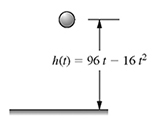Quadratic Equations in Engineering |
CHAPTER 2 |
In this chapter, the applications of quadratic equations in engineering are introduced. It is assumed that students are familiar with this topic from their high school algebra course. A quadratic equation is a second-order polynomial equation in one variable that occurs in many areas of engineering. For example, the height of a ball thrown in the air can be represented by a quadratic equation. In this chapter, the solution of quadratic equations will be obtained by three methods: factoring, the quadratic formula, and completing the square.
2.1 A PROJECTILE IN A VERTICAL PLANE
Suppose a ball thrown upward from the ground with an initial velocity of 96 ft/s reaches a height h(t) after time t s as shown in Fig. 2.1. The height is expressed by the quadratic equation h(t) = 96 t − 16 t2 ft. Find the time t in seconds when h(t) = 80 ft.

Figure 2.1 A ball thrown upward to a height of h(t).
Solution:
h(t) = 96 t − 16 t2 = 80
or
![]()
Equation (2.1) is a quadratic equation of the form ax2 + bx + c = 0 and will be solved using three different methods.
Method 1: Factoring Dividing equation (2.1) by 16 yields
![]()
Equation (2.2) can be factored as
(
Get Introductory Mathematics for Engineering Applications now with the O’Reilly learning platform.
O’Reilly members experience books, live events, courses curated by job role, and more from O’Reilly and nearly 200 top publishers.

